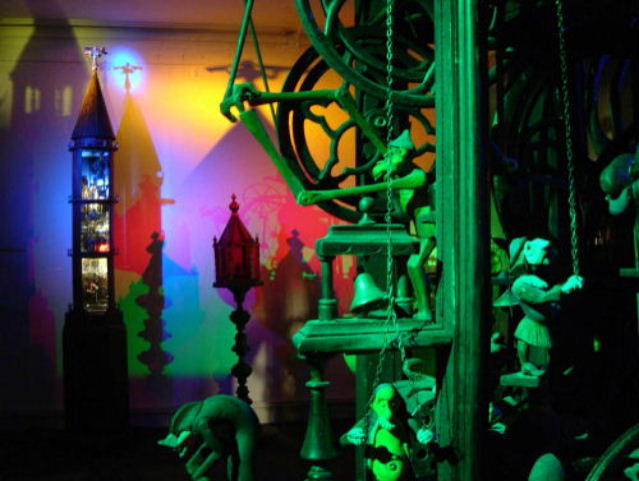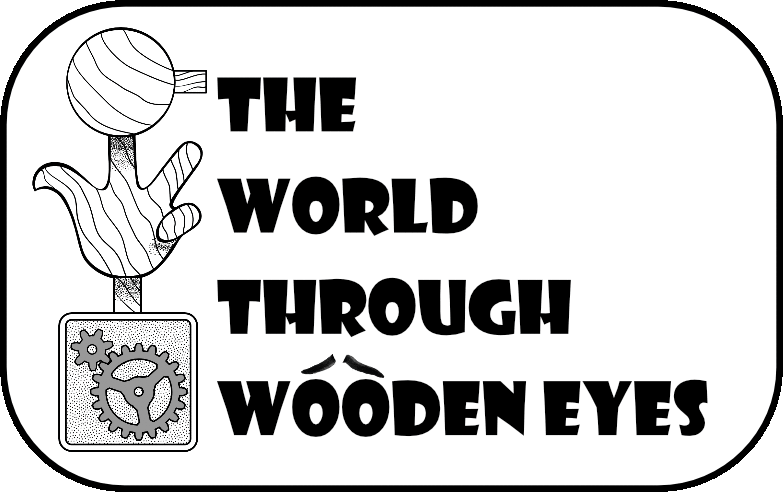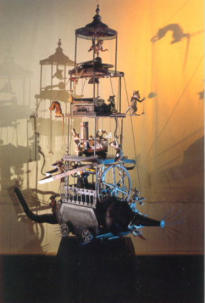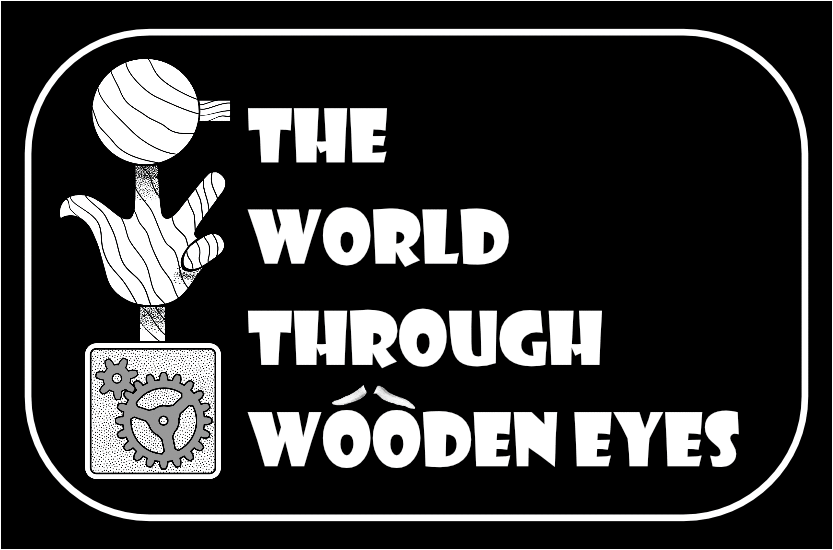NAVIGATION
SOCIAL
CONTACT
e-mail: info@theworldthroughwoodeneyes.co.uk

SHARMANKA
(Russian
for
barrel
organ)
is
a
collaboration
between
the
sculptor
-
mechanic
Eduard
Bersudsky
and
the
theatre
director
Tatyana
Jakovskaya,
which
began
in
Russia
in 1988.
A
self-taught
visionary
artist,
Eduard
(b.1939)
started
carving
when
he
was
25.
While
making
a
modest
living
as
a
metal
worker,
electrician,
skipper
on
the
barge,
night
guard
and a boiler man, he spent a lot of time in libraries, exhibitions, and evening classes for drawing and sculpture.
In
1974-80
Bersudsky
took
part
in
some
exhibitions
of
non-conformist
art
-
a
movement
of
artists
who
wanted
to
avoid
the
control
of
official
ideology.
They
attracted
a
lot
of
public attention - and the furious anger of the KGB.
In
1974-1986
he
worked
as
a
park
keeper,
carving
giant
figures
for
playgrounds
in
Leningrad
parks
and
gardens.
At
the
same
time
he
began
producing
the
kinemats
-
kinetic
sculptures
driven
by
electrical
motors
and
controlled
by
sophisticated
electro
mechanical
devices,
incorporating
pieces
of
old
furniture,
metal
scrap
and
grotesque
carved
figures
(the
first
was
made
in
1968).
Until
1989
he
kept
them
in
his
own
private
room
activating
them
only
for
a
few
friends
and
never
thinking
about
any
public
exhibition
(which
would
be anyway impossible under communist regime).
Tatyana
who
was
brought
to
Eduard's
flat
by
the
mutual
friend,
had
recognised
this
sculptures
as
an
ultimate
theatre
and
arranged
a
performance,
where
mechanical
movement
of
kinemats
was
supported
with
music,
light
and
shadow
play.
Sharmanka
Kinetic
Theatre
was
launched
in
1989
in
St.
Petersburg
on
the
premises of a former kindergarten.
In
1990
the
exhibition
of
Jean
Tinguely
in
Moscow
inspired
Eduard
to
make
three
kinemats
which
performed
a
15-minutes
piece
"Proletarian
Greetings
to
Honourable
Jean
Tinguely
from
Master
Eduard
Bersudsky
out
of
the
Cradle
of
Three Revolutions"
In
1991
Sharmanka
was
invited
to
perform
at
the
International
puppet
festival
in
Utrecht (Netherlands)
Sergey
Jakovsky
joined
the
team
in
1992
at
the
age
of
12
to
grow
over
the
years
into lighting designer and technical manager of Sharmanka.
In
1993
Sharmanka
left
Russia
because
of
the
increasing
economic
depression
and
the
withdrawal
of
the
local
authorities'
support
for
art.
Julian
Spalding,
then
Director
of
Glasgow
Museums,
invited
Sharmanka
to
make
exhibition
in
McLellan
Galleries and purchased three sculptures for the Glasgow Gallery of Modern Art.
In
1993-1995
the
Sharmanka
workshop
was
situated
in
a
small
old
country
house
in
the
village
of
Blainslie
in
the
Scottish
Borders,
next
to
and
under
the
wing
of
the
Scottish
sculptor
and
furniture-maker
Tim
Stead(1952-2000)
and
his
wife
Maggy
Lenert,
linguist
and
graphic
artist,
who
have
been
supporting
Sharmanka since their first meeting in St. Petersburg in 1990.
In
1995
the
Sharmanka
Kinetic
Gallery
and
Workshop
moved
to
Glasgow,
into
a
derelict
warehouse
in
the
old
Merchant
City
(14
King
Street/109
Trongate)
.
In
1996
Sharmanka
received
a
significant
grant
from
the
National
Lottery
and
Glasgow
City
Council
to
build a performance hall and improve public access to the gallery.
New
kinemats
have
been
added
to
the
show
every
year.
At
the
moment
there
are
three
dozen
kinemats
at
the
gallery,
performing
an
hour-long
show
for
a
wide
range
of
groups:
tourists
from
all
over
the
world,
schoolchildren,
community
groups,
students, people with special needs.
The
biggest
project
undertaken
by
Sharmanka
so
far
is
the
Millennium
Clock
Tower
for
the
Royal
Museum
(in
cooperation
with
late
Tim
Stead,
Annica
Sandstrom
and
Jurgen
Tubbecke)
which
was
later
included
into
permanent
collection
of
the
National
Museums of Scotland.
Other
commissions
include
kinetic
sculptures
“World
of
Artist.
Homage
to
Storm
P.”
for
Storm
P.
Museum
in
Copenhagen,
“Homage
to
Leonardo”
for
the
Big
Idea,
Centre
for
Inventors
and
Inventions
in
Irvine,
“St.Mungo
at
the
Tron”
for
Tron
Steeple
in Glasgow, “The Flight” for Bloomfield Science Museum in Jerusalem.
In
2000
Friends
of
Sharmanka
was
awarded
the
National
Lottery
Grant
for
3
years
programme
for
children
and
young
people
that
was
matched
by
Arts
Development
Grant
of
Culture
and
Leisure
Services
of
Glasgow
City
Council
and
private
donations.
This
programme
allowed
Sharmanka
to
improve
public
facilities
and
provide
free
performances-workshops
for
schools
and
other
groups, as well as to give free access for children to the performances.
In
January
2002
Sharmanka
made
its
London
debut
at
the
London
International
Mime
Festival
with
“Noah’s
Ark”,
performing
at
the
foyer
of
the
Royal
National
Theatre
at
South
Bank.
The
success
of
the
show
led
to
the
major
exhibition
at
Theatre
Museum
(Covent Garden), which run for 14 months and attracted more than 25,000 visitors.
In
2002
Sergey
Jakovsky
received
a
BA
in
technical
theatre
from
the
Royal
Scottish
Academy
of
Music
and
Drama
and
now
is
making his way up in theatrical lighting design.
In
2005
Eduard
Bersudsky
won
prestigious
Creative
Scotland
Award,
which
funded
co-operation
between
Sharmanka
and
Derevo Dance Theatre Company - a performance "The Druid Clock" at the Royal Museum.
In
2005
Sharmanka
launched
a
touring
exhibition
of
specially
designed
set
of
medium
and
smaller
size
kinetic
sculptures
“Sharmanka
Travelling
Circus”
with
support
of
SAC
National
Lottery
Grant
and
grant
of
The
Foundation
for
Sport
and
the
Arts,
which toured Stornoway, Falkirk, Inverness, Thurso and Kingussie. This exhibition attracted more than 25,000 visitors.
In
2006
Sharmanka
became
a
part
of
"Trongate
103"
project
-
an
ambitious
undertaking
of
Glasgow
City
Council
to
build
a
centre
for
visual
art
at
King
Street/Trongate.
For
the
period of building works Sharmanka Gallery was temporary relocated to 64 Osborne Street.
Text and images taken courtesy the Sharmanka website.
sharmanka



CONTACT
e-mail: info@theworldthroughwoodeneyes.co.uk
SOCIAL

sharmanka
SHARMANKA
(Russian
for
barrel
organ)
is
a
collaboration
between
the
sculptor
-
mechanic
Eduard
Bersudsky
and
the
theatre
director
Tatyana
Jakovskaya,
which
began
in
Russia
in
1988.
A
self-taught
visionary
artist,
Eduard
(b.1939)
started
carving
when
he
was
25.
While
making
a
modest
living
as
a
metal
worker,
electrician,
skipper
on
the
barge,
night
guard
and
a
boiler
man,
he
spent
a
lot
of
time
in
libraries,
exhibitions,
and
evening classes for drawing and sculpture.
In
1974-80
Bersudsky
took
part
in
some
exhibitions
of
non-
conformist
art
-
a
movement
of
artists
who
wanted
to
avoid
the
control
of
official
ideology.
They
attracted
a
lot
of
public
attention - and the furious anger of the KGB.
In
1974-1986
he
worked
as
a
park
keeper,
carving
giant
figures
for
playgrounds
in
Leningrad
parks
and
gardens.
At
the
same
time
he
began
producing
the
kinemats
-
kinetic
sculptures
driven
by
electrical
motors
and
controlled
by
sophisticated
electro
mechanical
devices,
incorporating
pieces
of
old
furniture,
metal
scrap
and
grotesque
carved
figures
(the
first
was
made
in
1968).
Until
1989
he
kept
them
in
his
own
private
room
activating
them
only
for
a
few
friends
and
never
thinking
about
any
public
exhibition
(which
would
be
anyway
impossible under communist regime).
Tatyana
who
was
brought
to
Eduard's
flat
by
the
mutual
friend,
had
recognised
this
sculptures
as
an
ultimate
theatre
and
arranged
a
performance,
where
mechanical
movement
of
kinemats
was
supported
with
music, light and shadow play.
Sharmanka
Kinetic
Theatre
was
launched
in
1989
in
St.
Petersburg
on
the
premises
of
a former kindergarten.
In
1990
the
exhibition
of
Jean
Tinguely
in
Moscow
inspired
Eduard
to
make
three
kinemats
which
performed
a
15-minutes
piece
"Proletarian
Greetings
to
Honourable
Jean
Tinguely
from
Master
Eduard
Bersudsky
out
of
the
Cradle
of
Three
Revolutions"
In
1991
Sharmanka
was
invited
to
perform
at
the
International puppet festival in Utrecht (Netherlands)
Sergey
Jakovsky
joined
the
team
in
1992
at
the
age
of
12
to
grow
over
the
years
into
lighting
designer
and
technical
manager of Sharmanka.
In
1993
Sharmanka
left
Russia
because
of
the
increasing
economic
depression
and
the
withdrawal
of
the
local
authorities'
support
for
art.
Julian
Spalding,
then
Director
of
Glasgow
Museums,
invited
Sharmanka
to
make
exhibition
in
McLellan
Galleries
and
purchased
three
sculptures
for
the
Glasgow Gallery of Modern Art.
In
1993-1995
the
Sharmanka
workshop
was
situated
in
a
small
old
country
house
in
the
village
of
Blainslie
in
the
Scottish
Borders,
next
to
and
under
the
wing
of
the
Scottish
sculptor
and
furniture-maker
Tim
Stead(1952-2000)
and
his
wife
Maggy
Lenert,
linguist
and
graphic
artist,
who
have
been
supporting
Sharmanka since their first meeting in St. Petersburg in 1990.
In
1995
the
Sharmanka
Kinetic
Gallery
and
Workshop
moved
to
Glasgow,
into
a
derelict
warehouse
in
the
old
Merchant
City
(14
King
Street/109
Trongate)
.
In
1996
Sharmanka
received
a
significant
grant
from
the
National
Lottery
and
Glasgow
City
Council
to
build
a
performance
hall
and
improve
public
access
to the gallery.
New
kinemats
have
been
added
to
the
show
every
year.
At
the
moment
there
are
three
dozen
kinemats
at
the
gallery,
performing
an
hour-long
show
for
a
wide
range
of
groups:
tourists
from
all
over
the
world,
schoolchildren,
community
groups, students, people with special needs.
The
biggest
project
undertaken
by
Sharmanka
so
far
is
the
Millennium
Clock
Tower
for
the
Royal
Museum
(in
cooperation
with
late
Tim
Stead,
Annica
Sandstrom
and
Jurgen
Tubbecke)
which
was
later
included
into
permanent
collection
of
the
National Museums of Scotland.
Other
commissions
include
kinetic
sculptures
“World
of
Artist.
Homage
to
Storm
P.”
for
Storm
P.
Museum
in
Copenhagen,
“Homage
to
Leonardo”
for
the
Big
Idea,
Centre
for
Inventors
and
Inventions
in
Irvine,
“St.Mungo
at
the
Tron”
for
Tron
Steeple
in
Glasgow,
“The
Flight”
for
Bloomfield
Science
Museum in Jerusalem.
In
2000
Friends
of
Sharmanka
was
awarded
the
National
Lottery
Grant
for
3
years
programme
for
children
and
young
people
that
was
matched
by
Arts
Development
Grant
of
Culture
and
Leisure
Services
of
Glasgow
City
Council
and
private
donations.
This
programme
allowed
Sharmanka
to
improve
public
facilities
and
provide
free
performances-workshops
for
schools
and
other
groups,
as
well
as
to
give
free
access
for
children to the performances.
In
January
2002
Sharmanka
made
its
London
debut
at
the
London
International
Mime
Festival
with
“Noah’s
Ark”,
performing
at
the
foyer
of
the
Royal
National
Theatre
at
South
Bank.
The
success
of
the
show
led
to
the
major
exhibition
at
Theatre
Museum
(Covent
Garden),
which
run
for
14
months
and attracted more than 25,000 visitors.
In
2002
Sergey
Jakovsky
received
a
BA
in
technical
theatre
from
the
Royal
Scottish
Academy
of
Music
and
Drama
and
now
is making his way up in theatrical lighting design.
In
2005
Eduard
Bersudsky
won
prestigious
Creative
Scotland
Award,
which
funded
co-operation
between
Sharmanka
and
Derevo
Dance
Theatre
Company
-
a
performance
"The
Druid
Clock" at the Royal Museum.
In
2005
Sharmanka
launched
a
touring
exhibition
of
specially
designed
set
of
medium
and
smaller
size
kinetic
sculptures
“Sharmanka
Travelling
Circus”
with
support
of
SAC
National
Lottery
Grant
and
grant
of
The
Foundation
for
Sport
and
the
Arts,
which
toured
Stornoway,
Falkirk,
Inverness,
Thurso
and
Kingussie. This exhibition attracted more than 25,000 visitors.
In
2006
Sharmanka
became
a
part
of
"Trongate
103"
project
-
an
ambitious
undertaking
of
Glasgow
City
Council
to
build
a
centre
for
visual
art
at
King
Street/Trongate.
For
the
period
of
building
works
Sharmanka
Gallery
was
temporary
relocated
to
64 Osborne Street.
Text and images taken courtesy the Sharmanka website.


































